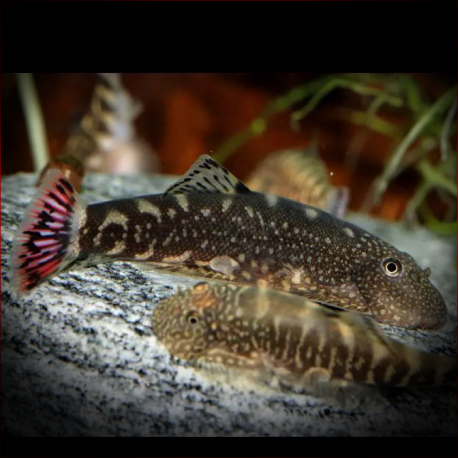More info
Datasheet
| Minimum Tank Size | 60 litres / 15.85 US gallons |
| Maximum Size | 4.5cm / 1.77inches |
| Temperature | 20°C / 68.00°F - 24°C / 75.20°F |
| Hardness | 1.01dgH / 18ppm - 12.05dgH / 215ppm |
| pH | 6.0-7.5 |
General Description
Gastromyzon Ocellatus, commonly known as the Borneo Sucker or Butterfly Loach, is a peaceful member of the Gastromyzontidae family. They are typically dark brown in color with cream bars and vertical bars on their flank forming an ocellus pattern. These loaches have adapted morphological features for life in fast-flowing waters, with flattened bodies and horizontally oriented paired fins that form a powerful sucking cup.
Aquarium Setup
For Gastromyzon Ocellatus, a minimum tank size of 60 liters is recommended, along with clean, well-oxygenated water. It's crucial to have a strong filtration system with a turnover rate of 10-15 times per hour. The tank should include a substrate of gravel or sand, water-worn rocks, pebbles, and aged driftwood. Live aquatic plants like Microsorum, Crinum, and Anubias spp. can also be added, providing additional cover and grazing surfaces. Water parameters should be maintained at a pH of 6.0-7.5, hardness of 18-215ppm, and a temperature of 20-24°C.
Behaviour
Gastromyzon Ocellatus is very peaceful but can be territorial to an extent, especially when it comes to prime feeding spots. They tend to thrive in loose aggregations, showcasing interesting behavior when kept in groups of four or more. These loaches prefer facing into the flow of water in their habitat, utilizing their specialized morphology to forage and cling to solid surfaces.
Feeding and Diet
In the wild, Gastromyzon Ocellatus primarily feeds on benthic algae and microorganisms. In captivity, they accept a diet of high-quality dried foods, live or frozen bloodworms, and homemade gelatin-bound foods rich in fresh vegetables and Spirulina. Maintaining a mature aquarium with ample algae-covered surfaces is essential for their long-term health. Additionally, providing a separate tank to grow algae for cyclical introduction can be beneficial, especially if the main tank lacks sufficient algae growth.
Reproduction & Dimorphism
Breeding Gastromyzon Ocellatus in captivity is rare, with observed attempts involving specific temperature adjustments and rich diets to induce spawning. Adult females are larger and heavier-bodied than males, with noticeable differences in body shape when viewed from above or below. Successful breeding has been reported with other Gastromyzon species in larger tanks containing suitable substrates, plants, and aeration.
Habitat and Distribution
Endemic to Borneo, Gastromyzon Ocellatus is found specifically in the Sungai Sarawak drainage area in southern Sarawak, Malaysian Borneo. These loaches inhabit swift, shallow streams with gravel and rock substrates covered in algae and biofilm. They are often located above or below waterfalls and prefer partially shaded areas with clear, oxygen-rich water levels ranging from sea level to 1350 meters above sea level. Sympatric occurrences have been noted with other Gastromyzon species in the wild.

